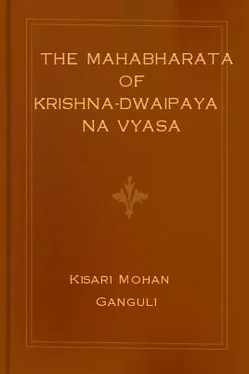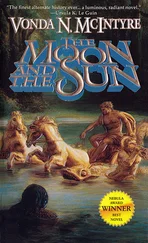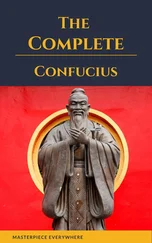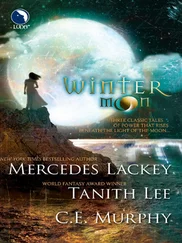Kisari Mohan Ganguli - The Mahabharata of Krishna-Dwaipayana Vyasa
Здесь есть возможность читать онлайн «Kisari Mohan Ganguli - The Mahabharata of Krishna-Dwaipayana Vyasa» весь текст электронной книги совершенно бесплатно (целиком полную версию без сокращений). В некоторых случаях можно слушать аудио, скачать через торрент в формате fb2 и присутствует краткое содержание. Издательство: ManyBooks.net, Жанр: на английском языке. Описание произведения, (предисловие) а так же отзывы посетителей доступны на портале библиотеки ЛибКат.
- Название:The Mahabharata of Krishna-Dwaipayana Vyasa
- Автор:
- Издательство:ManyBooks.net
- Жанр:
- Год:неизвестен
- ISBN:нет данных
- Рейтинг книги:3 / 5. Голосов: 1
-
Избранное:Добавить в избранное
- Отзывы:
-
Ваша оценка:
- 60
- 1
- 2
- 3
- 4
- 5
The Mahabharata of Krishna-Dwaipayana Vyasa: краткое содержание, описание и аннотация
Предлагаем к чтению аннотацию, описание, краткое содержание или предисловие (зависит от того, что написал сам автор книги «The Mahabharata of Krishna-Dwaipayana Vyasa»). Если вы не нашли необходимую информацию о книге — напишите в комментариях, мы постараемся отыскать её.
The Mahabharata of Krishna-Dwaipayana Vyasa — читать онлайн бесплатно полную книгу (весь текст) целиком
Ниже представлен текст книги, разбитый по страницам. Система сохранения места последней прочитанной страницы, позволяет с удобством читать онлайн бесплатно книгу «The Mahabharata of Krishna-Dwaipayana Vyasa», без необходимости каждый раз заново искать на чём Вы остановились. Поставьте закладку, и сможете в любой момент перейти на страницу, на которой закончили чтение.
Интервал:
Закладка:
114. The sense seems to be that through these one succeeds in taking birth as a Brahmana.
115. A repetition occurs here of about 5 verses. The passage is evidently an interpolation originally caused by carelessness.
116. Nilakantha explains that this implies that one should regard these as really undistinguished from the mind. Indeed, created by the mind itself, these should always be taken as having no real existence beyond the mind.
117. 'That' here refers to the attenuation of all things by absorption into the mind.
118. Gunagunam is treating the qualities as not qualities; i.e., regarding bravery, magnanimity, etc, as really not merits, for these lead to pride. Ekacharyyam is ekantavasam, i.e., life in seclusion, or living without depending upon others. Anantaram is nirastasamastabheda or non-recognition of all distinctions. Some texts read Brahmamatah meaning 'existing among Brahmanas'. Ekapadam sukham is samastasukhagarbham, i.e., the source or fountain of all happiness.
119. The two deities are Jiva and Iswara.
120. The correct reading, in 53 seems to be samsargabhiratam and not samsayabhiratam.
121. In the second line, the correct words are martya and sarva. The sense of the second line seems to be that this body is ceaselessly revolving, for Emancipation is difficult to achieve. Hence this body is, as it were, the wheel of Time. Nilakantha's explanation does not seem to be satisfactory.
122. I do not think that Telang is correct in his version of this verse. What is said here seems to be this. The body is, as it were the wheel of Time; the body is the ocean of delusion; the body is the creator, destroyer and reawakener of the universe. Through the body creatures act, and hence creation, destruction, and re-creation are due to the body. This accords with what is said elsewhere regarding the body.
123. It would be wrong to take satah as implying 'the good,' the finite verses in every text being singular.
124. The correct reading seems to be atmana as the last word of the first line, and not atman.
125. What is said here is that the quality of passion predominates in these.
126. Nyagrodha is the Ficus Bengalensis, Linn. Jamvu is Eugenia Jambolana, Lamk. Pippala is Ficus religiosa, Linn. Salmali is Bombax Malabaricum. Sinsapa is Dalbergia Sissoo, Roxb. Meshasringa is Asclepia geminata, Roxb. Kichaka is a variety of mountain bamboo. Here however it evidently implies the Nimba or Melia Azadirachta, Linn.
127. Nilakantha is for taking the second line as consisting of two propositions. It would be better to take satinam as referring to strinam, and vasumatyah, as an adjective of Apsarasah.
128. The sense seems to be that good men never allow others to know what their acts are. They are strangers to ostentation.
129. The sense seems to be that the knowledge of one's own identity and of things as discriminated from one another is presided over by Prakriti. If the question is asked whence is the knowledge--'I am so,' and that 'this is so,' the answer is that it comes from Prakriti or Nature.
130. As explained by Nilakantha, the word Savitri is used here to imply all forms of worship observed by Brahmanas, etc, and the Mlecchas as well. This turning back to explain a word used before is said to be an instance of "looking back like the lion".
131. Telang, I think, renders this verse wrongly. In the first line it is said that Brahman is superior to the Prajapatis. In the second it is pointed out that Vishnu is superior to Brahman.
132. It is difficult to understand which part of the wheel is intended to be expressedly 'bandhanam' or the bond; I take it for the spokes. Pariskandha is Samuha or the materials that together compose an object. Here it may be taken for the nave or centre. Home is called the circumference, because, as the circumference limits the wheel, even so home (wife and children) limits the affections and acts of life.
133. The words Kalachakram pravartate have been rendered in the first verse of this lesson. In verse 9, the words asaktaprabhavapavyam are explained by Nilakantha differently. Manas-krantam, I take, is equivalent to 'be bounded by the mind,' I do not know whence Telang gets 'never fatigued' as the substitute of this word.
134. Implying that he should go to the house of his preceptor, study and serve there, and after completing his course, return for leading a life of domesticity.
135. The sense seems to be that these last three duties are productive of merit and should, therefore, be performed. The first three however, are sources of living.
136. Havishya is food cooked in a particular way and offered to the deities. It must be free from meat. There may be milk or ghee in it, but the cooking must be done in a single pot or vessel continuously; no change of vessels is allowed.
137. Vilwa is the Aegle marmelos, and Palasa is the Butea frondosa of Roxburgh.
138. At first he should live on fruits and roots and leaves, etc. Next on water, and then on air. There are different sects of forests recluses. The course of life is settled at the time of the initiatory rites.
139. What is stated here is this. The Sannyasin should not ask for alms: or, if he ever seeks for aims, he should seek them in a village or house where the cooking has been already done and where every one has already eaten. This limitation is provided as otherwise the Sannyasin may be fed to his fill by the householder who sees him.
140. He should never plunge into a stream or lake or tank for bathing.
141. Kalakankhi implies, probably 'simply biding time', i.e., allowing time to pass indifferently over him.
142. The sense seems to be this; the self or soul is without qualities. He who knows the self, or rather he who pursues the self with the desire of knowing it, should practise the truths of Piety laid down above. They constitute the path that leads to the self.
143. 'That which has Brahman for its origin' implies the Vedas.
144. Commentators differ about what is implied by the ten or the twelve. Nilakantha thinks that the ten mean the eight characteristics of Yoga, viz., Yama, Niyama, Asana, Pranayama, Pratyahara, Dharana, Dhyana, Samadhi, and Tarka and Vairagya. The twelve would imply the first eight, and these four, viz., Maitri, Karuna, Mudita, and Upeksha. If ten plus twelve or two and twenty be taken, then that number would be made up by the five modes of Yama, the five of Niyama, the remaining six of Yoga (beginning with Asana and ending with Samadhi), the four beginning with Maitri, and the two, viz., Tarka and Vairagya.
145. What is said in this Lesson seems to be this: the Unmanifest or Prakriti is that condition in which all the three qualities of Goodness, Passion, and Darkness exist in a state of combination. The unmanifest is the condition existing before creation. When one particular quality, viz., Goodness prevails over the others, there arises Purusha, viz., that from whom everything flows. The relation of Purusha and Nature is both unity and diversity. The three illustrations of the Gnat and the Udumbara the fish and water, and water drops and the lotus leaf, explain the relation between Purusha and Nature. He is in Nature, yet different from it. There is both association and dissociation.
146. The doubts appertain to duties, that is whether they should be done or not, and whether they have any effects here and hereafter.
147. The thinking or enjoying agent is subject, and that which is thought or enjoyed is object. Subject and object an two well known words in Sir W. Hamilton's philosophy. I follow Telang in adopting them.
148. Sattawa pradipa, rendered 'light of Nature,' implies, as Nilakantha explains, knowledge, which is a manifestation of Nature. Arjuna Misra's interpretation seems to be better. He says that knowledge,--that is, knowledge of truth,--is acquired by the self through Nature.
Читать дальшеИнтервал:
Закладка:
Похожие книги на «The Mahabharata of Krishna-Dwaipayana Vyasa»
Представляем Вашему вниманию похожие книги на «The Mahabharata of Krishna-Dwaipayana Vyasa» списком для выбора. Мы отобрали схожую по названию и смыслу литературу в надежде предоставить читателям больше вариантов отыскать новые, интересные, ещё непрочитанные произведения.
Обсуждение, отзывы о книге «The Mahabharata of Krishna-Dwaipayana Vyasa» и просто собственные мнения читателей. Оставьте ваши комментарии, напишите, что Вы думаете о произведении, его смысле или главных героях. Укажите что конкретно понравилось, а что нет, и почему Вы так считаете.












